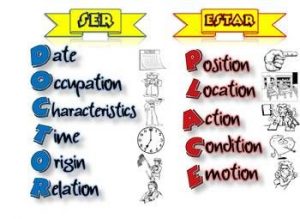Ser vs Estar

Ser vs Estar: Sometimes two or more words in one language are expressed by a single word in another. For example, English to do and to make are both expressed by Spanish HACER. Another good example is Llevar and Traer are both expressed by English BRING.
Likewise to be has numerous equivalents in Spanish, among them are SER and ESTAR. There are two verbs in Spanish which have the English meaning TO BE.
These verbs are SER vs ESTAR. Each of these verbs has very definite uses and they are not interchangeable.
The verb SER is derived from the Latin verb ESSE from which is also derived the English word ESSENCE. The verb SER is therefore used to express an inherent quality or characteristic.
The verb ESTAR on the other hand, is derived from the Latin verb STARE from which is also derived the word state.
The verb ESTAR is therefore used to express a temporary state or condition. When a noun follows the verb to be , it is called the predicate nominative. Since in such a sentence the subject and predicative nominative are the same person or thing, the verb SER is always used. The verb SER is used to express origin; where someone or something is from.
When an adjective follows the verb TO BE, either the verb SER or ESTAR can be used. HOWEVER, the verb used depends upon the meaning the speaker wishes to convey.
Characteristic: In order to express an inherent quality or characteristic the verb SER is used. It is very important that you understand the messages in a sentence:
Example: Fernando es vivo ( Means Fernando is astute, he always wants to take advantage of everything.
Fernando está vivo ( means Fernando is alive)
SER indicates:
- Date / Description: Ella es mi hermana.
- Occupation: Mi hermana es doctora.
- Characteristic: Ella es bonita.
- Time: Es la una de la tarde.
- Origin: Yo soy de Nicaragua.
- Relation: Ella es mi madre
- Time or location of an event: La reunión es en el parque. La reunión es a las dos.
ESTAR expresses:
- Place: Los hermanos están sentados.
- Location: La casa está en el norte.
- Action: Samuel está estudiando.
- Condition: Mi cuarto está limpio.
- Emotion: Mi hermano está feliz.